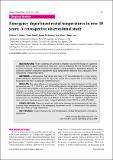| dc.contributor.author | Walker, Graham A. | en_US |
| dc.contributor.author | Runde, Daniel | en_US |
| dc.contributor.author | Rolston, Daniel M. | en_US |
| dc.contributor.author | Wiener, Dan | en_US |
| dc.contributor.author | Lee, Jarone | en_US |
| dc.date.accessioned | 2014-10-01T14:29:18Z | |
| dc.date.issued | 2013 | en_US |
| dc.identifier.citation | Walker, Graham A., Daniel Runde, Daniel M. Rolston, Dan Wiener, and Jarone Lee. 2013. “Emergency department rectal temperatures in over 10 years: A retrospective observational study.” World Journal of Emergency Medicine 4 (2): 107-112. doi:10.5847/wjem.j.1920-8642.2013.02.004. http://dx.doi.org/10.5847/wjem.j.1920-8642.2013.02.004. | en |
| dc.identifier.issn | 1920-8642 | en |
| dc.identifier.uri | http://nrs.harvard.edu/urn-3:HUL.InstRepos:12987378 | |
| dc.description.abstract | BACKGROUND: Fever in patients can provide an important clue to the etiology of a patient's symptoms. Non-invasive temperature sites (oral, axillary, temporal) may be insensitive due to a variety of factors. This has not been well studied in adult emergency department patients. To determine whether emergency department triage temperatures detected fever adequately when compared to a rectal temperature. METHODS: A retrospective chart review was made of 27 130 adult patients in a high volume, urban emergency department over an eight-year period who received first a non-rectal triage temperature and then a subsequent rectal temperature. RESULTS: The mean difference in temperatures between the initial temperature and the rectal temperature was 1.3 °F (P<0.001), with 25.9% of the patients having higher rectal temperatures ≥2 °F, and 5.0% having higher rectal temperatures ≥4 °F. The mean difference among the patients who received oral, axillary, and temporal temperatures was 1.2 °F (P<0.001), 1.8 °F (P<0.001), and 1.2 °F (P<0.001) respectively. About 18.1% of the patients were initially afebrile and found to be febrile by rectal temperature, with an average difference of 2.5 °F (P<0.001). These patients had a higher rate of admission (61.4%, P<0.005), and were more likely to be admitted to the hospital for a higher level of care, such as an intensive care unit, when compared with the full cohort (12.5% vs. 5.8%, P<0.005). CONCLUSIONS: There are significant differences between rectal temperatures and non-invasive triage temperatures in this emergency department cohort. In almost one in five patients, fever was missed by triage temperature. | en |
| dc.language.iso | en_US | en |
| dc.publisher | Second Affiliated Hospital of Zhejiang University School of Medicine | en |
| dc.relation.isversionof | doi:10.5847/wjem.j.1920-8642.2013.02.004 | en |
| dc.relation.hasversion | http://www.ncbi.nlm.nih.gov/pmc/articles/PMC4129836/pdf/ | en |
| dash.license | LAA | en_US |
| dc.subject | Rectal temperatures | en |
| dc.subject | Oral temperatures | en |
| dc.subject | Axillary temperatures | en |
| dc.subject | Emergency department | en |
| dc.title | Emergency department rectal temperatures in over 10 years: A retrospective observational study | en |
| dc.type | Journal Article | en_US |
| dc.description.version | Version of Record | en |
| dc.relation.journal | World Journal of Emergency Medicine | en |
| dash.depositing.author | Lee, Jarone | en_US |
| dc.date.available | 2014-10-01T14:29:18Z | |
| dc.identifier.doi | 10.5847/wjem.j.1920-8642.2013.02.004 | * |
| dash.contributor.affiliated | Lee, Jarone | |


